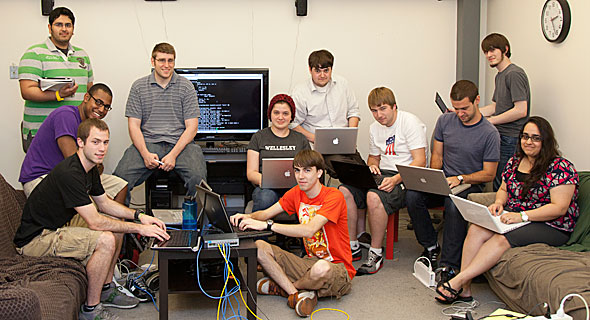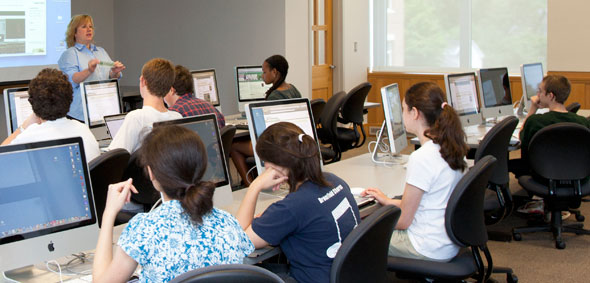
Menu
- About
- Academics
- Admissions & Financial Aid
- Student Support
- Diversity
- Postdocs
Back to Top Nav
Back to Top Nav
Back to Top Nav
Back to Top Nav
Back to Top Nav
Dartmouth’s Institute for Security, Technology, and Society (ISTS) is growing the next generation of leaders for the cyber security industry. This summer, in addition to co-hosting with Computing Services its fifth-annual Securing the eCampus Conference for information security professionals in higher education, ISTS offered the Secure Information Systems Mentoring and Training (SISMAT) course for college students and a week-long Security, Technology, and Society Camp for high school students.

Dartmouth’s SISMAT 2011 immersed undergraduate students from across the United States and beyond in the ways of cybersecurity. From left, first row: Justin Kearns (University of Scranton), Jonathan Grochowski (Lewis and Clark College), and Dalaa Al Qahtani (American University of Kuwait). Second row: Isaiah Sarju (Grinnell College), Marie Vasek (Wellesley College), Luke Korth (Cornell College), and Nathan Land (The Evergreen State College). Third row: Thamer Al-Mayyan (American University of Kuwait), Assistant Professor Michael Locasto (University of Calgary, SISMAT Lead Instructor), JK Slyby (Ouachita Baptist University), and Brendan Graham (Eastern Washington University). (photo by Joseph Mehling ’69)
Building capacity: The SISMAT course for college students, as lead instructor Michael Locasto explains, “addresses the nation’s shortage of skilled cyber security experts. Dartmouth hosts the program each summer, sharing expertise of faculty and researchers in computer science and computer security, while building a network of students and their mentors.” Locasto, formerly an ISTS research fellow at Dartmouth, is now a computer science professor at the University of Calgary in Alberta, Canada.
SISMAT students come to Dartmouth from other colleges and universities across the country where opportunities to study cyber security are more limited. For the first time this year, two students enrolled from the American University of Kuwait.
Drowning in hex code: SISMAT studies are an intense 10 days that students describe variously as “drinking from a fire hose” and “drowning in hex code.”
The immersion builds skills quickly, Locasto notes. “But even more than that, it nurtures a manner of mind, a way of looking at the field. Computer science is frequently taught in a compartmentalized way.” SISMAT takes a different approach, “meeting the boundaries, exploring them, breaking them, looking at what happens at the intersections” of various programs and systems. “That’s a point where those who want to do harm look.”
SISMAT Instructor Sergey Bratus adds, “We work to help the students and fellow academics navigate the rich and complex world of hacker research, and see the deep technological insights expressed in possibly unfamiliar form.” Bratus is also a research associate professor at Dartmouth and chief security advisor to ISTS.
Locksmiths: SISMAT student Justin Kearns from the University of Scranton says, “SISMAT calls for a shift in your state of mind, from studying computer science from the outside, to figuring how things work from the inside out. We’re adopting a security way of thinking—a hacker curriculum—in a positive sense.”
Preemptively uncovering a system’s flaws and weaknesses is a crucial skill for a cyber-security professional looking to outwit criminals. “We’re learning how to pick locks—partly to be able to be better at building them,” comments Isaiah Sarju from Grinnell College.
Real-world experience: Following the intensive, two-week, course, most SISMAT students go off to internships in industry, nonprofits, or academia. Dartmouth’s own Computing Services takes in some students to help test the College’s systems. Involving undergraduates in testing the security of its operational networks is a unique aspect of the Dartmouth’s learning environment. The practice was established through the Cyber Security Initiative, which brings together faculty, students, and staff to tackle some of the College’s toughest security challenges.
Network: These new skills, attitudes, and connections follow SISMAT students back to their own schools. “I’ve got lots to take back home, including things to tell my professors,” notes Dalaa Al Qahtani of the American University of Kuwait.
And it’s through the connections to the students’ home institutions, says Locasto, that some of the benefit of hosting the program each year accrues to Dartmouth.
“We’re in the fourth year of the program,” he points out. “As SISMAT alumni move into graduate studies, and later into professional lives, whether in academia, government service, or industry, they remain part of a network that connects them—and their colleagues—directly to Dartmouth.”

Susan Simon, media learning technologist at the Jones Media Center, leads high school students in a session of Dartmouth’s Security, Technology, and Society camp. (photo by Joseph Mehling ’69 )
Next Generation: But how do young people discover cyber security as an interesting field of study and practice?
For 10 teenaged students representing eight different high schools (in Japan, Massachusetts, Vermont, and New Hampshire), a week at Dartmouth opened that door, introducing participants to “current interdisciplinary research in cyber security and privacy with regard to information sharing technologies and the implications they have on our lives,” according to Suzanne Thompson, the ISTS high school summer program director and a research scientist at Dartmouth Medical School’s Norris Cotton Cancer Center.
The high schoolers—equipped with iPad IIs for the week—took part in “hands-on and interactive activities, augmented with field trips and guest speakers focusing on the human interaction in social computing, digital forensics, economic models, mobile sensors, and informatics in healthcare systems.” They were mentored by Lead Instructor Gabriel Weaver, a computer science doctoral student in security, and a team of Dartmouth graduate students and postdoctoral researchers.
Follow the trail: Begin with a photo of a birthday cake posted to Twitter and follow it all the way to a home street address.
That was one outcome of a camp activity led by ISTS research fellow and camp session leader Jacob Sorber. “The goal of my activity was to show the students how the use of technology leaves digital traces that people rarely think about.”
Beyond the possible wake-up call for less savvy tech users, “a secondary goal was to expose the students to a somewhat less conventional career option for those with security interests and skills: digital forensic investigator.”
Support structure: In addition to ISTS, the camp received content and logistical support from faculty and researchers associated with the Trustworthy Information Systems for Healthcare (TISH) project funded by the National Science Foundation (NSF), the Center for Digital Strategies at the Tuck School of Business, the Department of Computer Science, Dartmouth-Hitchcock Medical Center, and the Norris Cotton Cancer Center.
Shaping the future: The work of ISTS builds on a deep tradition of computer science at Dartmouth. And with cutting-edge research underway in areas such as machine learning, mobile sensing, computational biology, digital arts (including music and humanities), as well as security studies, Dartmouth continues to shape the field.

High school students attending Dartmouth’s 2011 Security, Technology, and Society camp were introduced to the study and practice of cyber security. Camp staff and faculty (back row, from left): Gabriel Weaver, computer science PhD candidate and lead instructor, and Suzanne Thompson, program director. Front row, from left: Ann Perbohner, physical sciences librarian, Juhee Kwon, ISTS postdoctoral research fellow, and Melanie Pastuck ’11, camp mentor. (photo courtesy of ISTS)